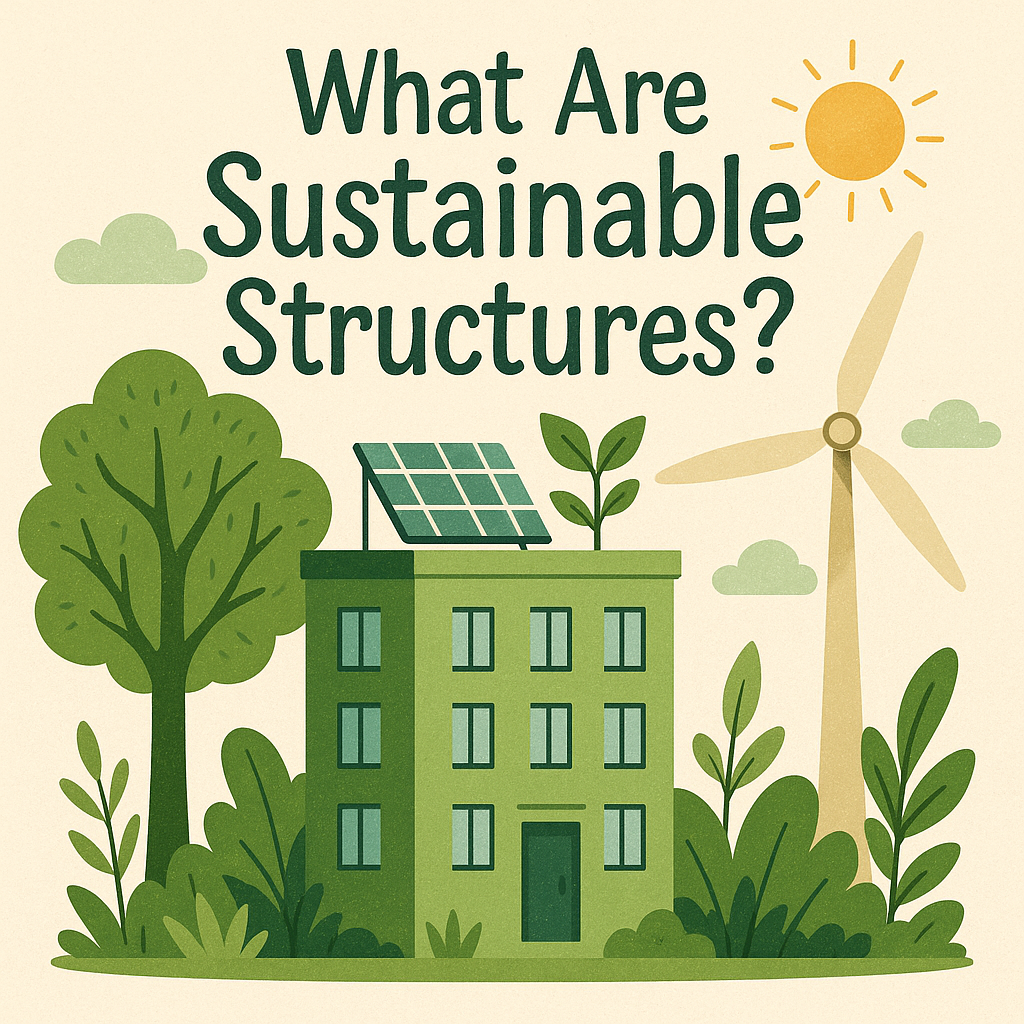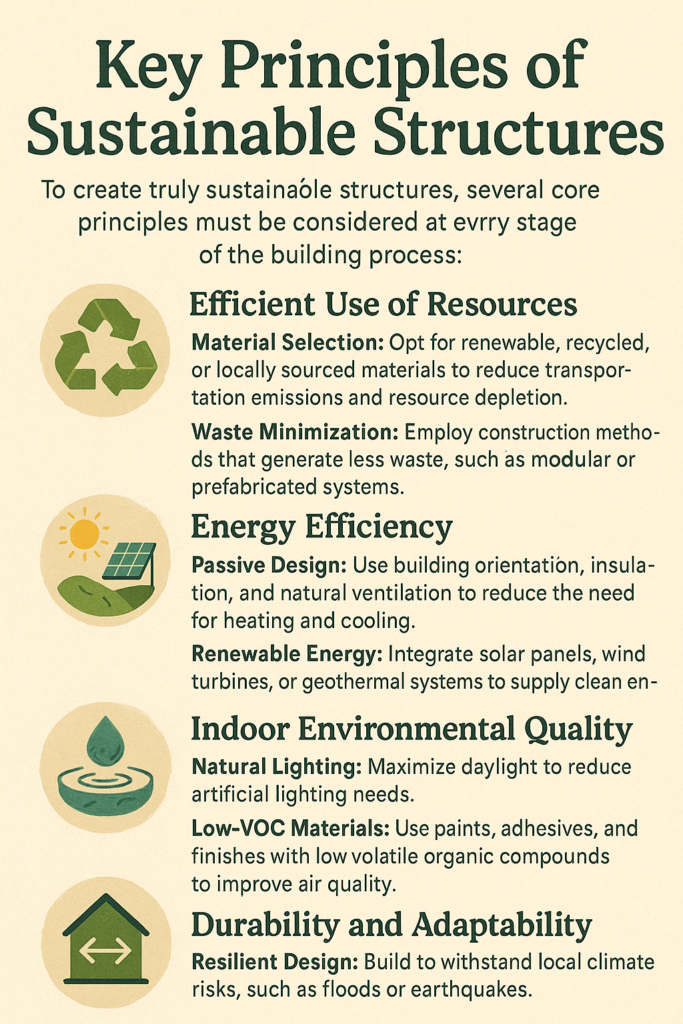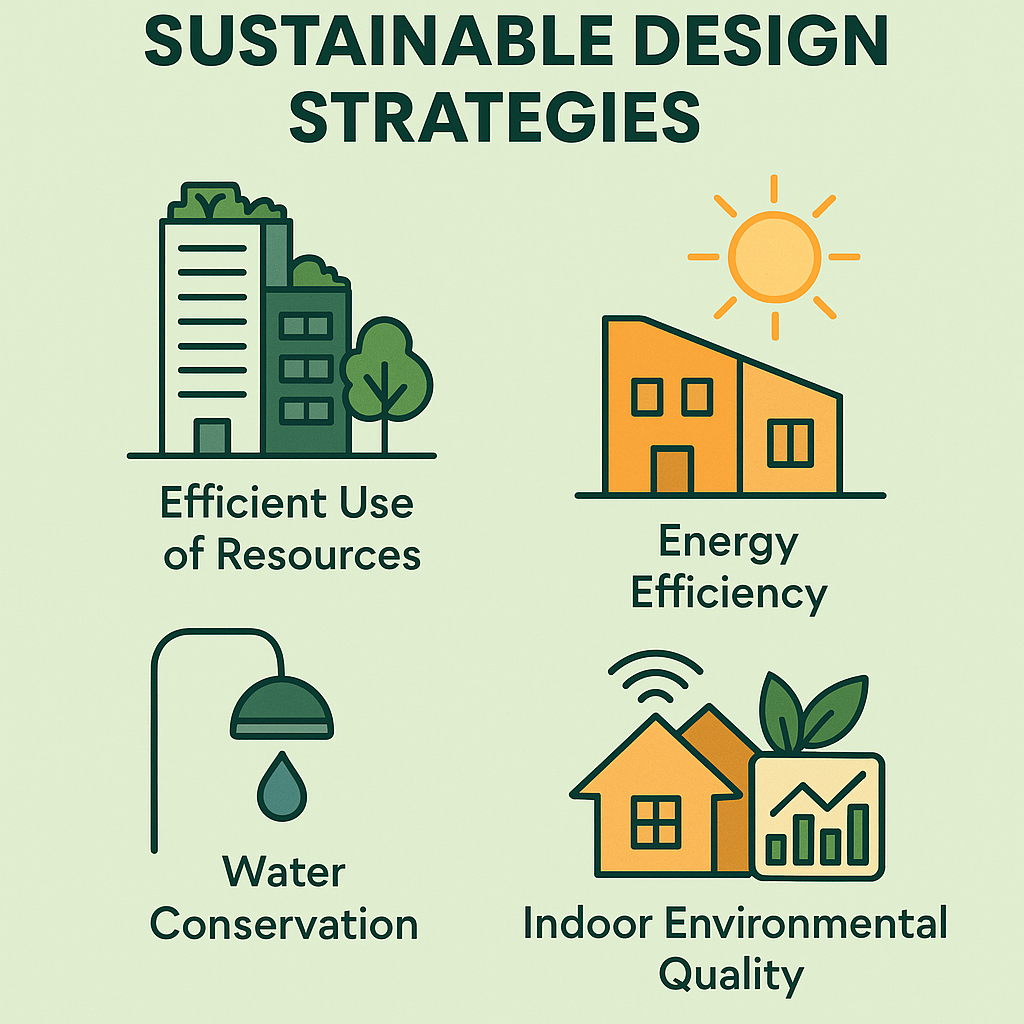Sustainability is no longer just a buzzword in the construction industry it’s a necessity. As environmental concerns and resource limitations intensify, the demand for sustainable structures has become central to modern construction. Property owners, developers, and engineers are increasingly seeking ways to minimize environmental impact, reduce energy consumption, and create buildings that stand the test of time both structurally and ecologically. In this blog, we’ll explore what makes structures sustainable, the latest eco-friendly approaches, and how you can integrate these principles into your next project.
What Are Sustainable Structures?
Sustainable structures are buildings or infrastructure designed, constructed, and maintained to minimize their environmental footprint throughout their lifecycle. This means considering everything from the sourcing of materials and energy efficiency to adaptability and end-of-life recycling. The goal is to create structures that are not only safe and durable but also resource-efficient and environmentally responsible.

Why Are Sustainable Structures Important?
The construction sector is responsible for a significant portion of global energy use and greenhouse gas emissions. Traditional building methods often consume large amounts of raw materials, produce waste, and result in structures that are energy-intensive to operate. Sustainable structures address these challenges by:
- Reducing energy and water consumption
- Lowering greenhouse gas emissions
- Minimizing construction and operational waste
- Enhancing occupant health and comfort
- Increasing resilience to climate change and natural disasters
By investing in sustainable structures, developers and owners can reduce long-term costs, improve property value, and contribute to a healthier planet.
Key Principles of Sustainable Structures:-
To create truly sustainable structures, several core principles must be considered at every stage of the building process:
1. Efficient Use of Resources
- Material Selection: Opt for renewable, recycled, or locally sourced materials to reduce transportation emissions and resource depletion.
- Waste Minimization: Employ construction methods that generate less waste, such as modular or prefabricated systems.
2. Energy Efficiency
- Passive Design: Use building orientation, insulation, and natural ventilation to reduce the need for heating and cooling.
- Renewable Energy: Integrate solar panels, wind turbines, or geothermal systems to supply clean energy.
3. Water Conservation
- Low-Flow Fixtures: Install water-saving appliances and fixtures.
- Rainwater Harvesting: Collect and reuse rainwater for landscaping or non-potable uses.
4. Indoor Environmental Quality
- Natural Lighting: Maximize daylight to reduce artificial lighting needs.
- Low-VOC Materials: Use paints, adhesives, and finishes with low volatile organic compounds to improve air quality.
5. Durability and Adaptability
- Resilient Design: Build to withstand local climate risks, such as floods or earthquakes.
- Flexible Spaces: Design interiors that can be adapted for future uses, extending the building’s lifespan.

Innovative Materials for Sustainable Structures:-
The materials used in construction have a profound impact on a building’s sustainability. Here are some of the most promising eco-friendly materials for sustainable structures:
- Bamboo: Fast-growing, renewable, and strong, bamboo is an excellent alternative to traditional timber.
- Recycled Steel: Using recycled steel reduces the need for virgin ore and energy-intensive manufacturing.
- Rammed Earth: Walls made from compacted earth offer excellent thermal mass and minimal embodied energy.
- Cross-Laminated Timber (CLT): Engineered wood panels that are strong, lightweight, and sequester carbon.
- Recycled Concrete: Incorporating recycled aggregates lowers the carbon footprint of concrete structures.
Sustainable Design Strategies:-
Design is at the heart of creating sustainable structures. Here are some strategies to consider:
1. Passive Solar Design
Position windows, walls, and floors to collect, store, and distribute solar energy during winter and reject it in summer. This reduces reliance on mechanical heating and cooling.
2. Green Roofs and Walls
Plant-covered roofs and walls improve insulation, reduce stormwater runoff, and create habitats for wildlife.
3. High-Performance Building Envelope
Invest in advanced insulation, airtight construction, and high-efficiency windows to minimize energy loss.
4. Smart Building Technologies
Integrate sensors, automation, and energy management systems to optimize performance and reduce waste.

Certifications for Sustainable Structures:-
Several certification programs help ensure that sustainable structures meet rigorous environmental standards:
- LEED (Leadership in Energy and Environmental Design): A globally recognized green building certification.
- BREEAM (Building Research Establishment Environmental Assessment Method): Widely used in Europe.
- WELL Building Standard: Focuses on health and well-being in building design.
Achieving these certifications demonstrates a commitment to sustainability and can enhance a building’s marketability and value.
The Role of Structural Engineers in Sustainable Structures:-
Structural engineers play a vital role in the creation of sustainable structures. Their expertise ensures that buildings are not only safe and robust but also optimized for material efficiency and adaptability. Key responsibilities include:
- Selecting low-impact materials and efficient structural systems
- Designing for disassembly and recycling at the end of the building’s life
- Collaborating with architects and MEP engineers to integrate sustainability goals
By prioritizing sustainability from the earliest design stages, structural engineers help reduce the environmental impact of construction and operation.
Challenges and Opportunities in Sustainable Structures:-
While the benefits of sustainable structures are clear, there are challenges to widespread adoption:
- Higher Upfront Costs: Sustainable materials and technologies can increase initial construction costs, though these are often offset by long-term savings.
- Knowledge Gaps: Not all professionals are familiar with the latest sustainable practices.
- Regulatory Barriers: Building codes and standards may lag behind innovative green technologies.
However, as awareness grows and technology advances, opportunities for sustainable structures are expanding rapidly. Incentives, improved materials, and better design tools are making it easier than ever to build green.
The Future of Sustainable Structures:-
The future of construction is undeniably green. Advances in materials science, digital design, and renewable energy are enabling even more ambitious sustainable structures. Expect to see:
- Greater use of circular economy principles, where materials are reused and recycled
- Smart buildings that automatically optimize energy and water use
- Integration of biophilic design, connecting occupants with nature
As cities grow and climate challenges intensify, sustainable structures will be at the forefront of resilient, healthy, and prosperous communities.
FAQs:-
Q1: What are the main benefits of sustainable structures?
A: Sustainable structures reduce environmental impact, lower operating costs, improve occupant health, and enhance property value.
Q2: Are sustainable structures more expensive to build?
A: They may have higher upfront costs, but long-term savings on energy, water, and maintenance often outweigh the initial investment.
Q3: Which materials are best for sustainable structures?
A: Bamboo, recycled steel, rammed earth, cross-laminated timber, and recycled concrete are among the top choices.
Q4: How can I certify my building as a sustainable structure?
A: Pursue certifications like LEED, BREEAM, or WELL by meeting their sustainability criteria during design and construction.
Q5: What role do structural engineers play in sustainable structures?
A: Structural engineers optimize material use, ensure durability, and collaborate on eco-friendly design strategies.
Conclusion:-
Sustainable structures represent the future of construction combining durability, efficiency, and environmental responsibility. By embracing eco-friendly materials, smart design, and innovative engineering, we can create buildings that benefit both people and the planet. If you’re planning a new project, consult with experts in sustainable structures to ensure your investment stands strong for generations to come.
Read More On:-
For more information about engineering, architecture, and the building & construction sector, go through the posts related to the same topic on the Specuwin Blog Page.
Find out more accurately what we are going to take off in the course of applying leading new technologies and urban design at Specuwin.
